- Home »
- China Guide »
- Culture »
- The 24 Solar Term
The 24 Solar Terms
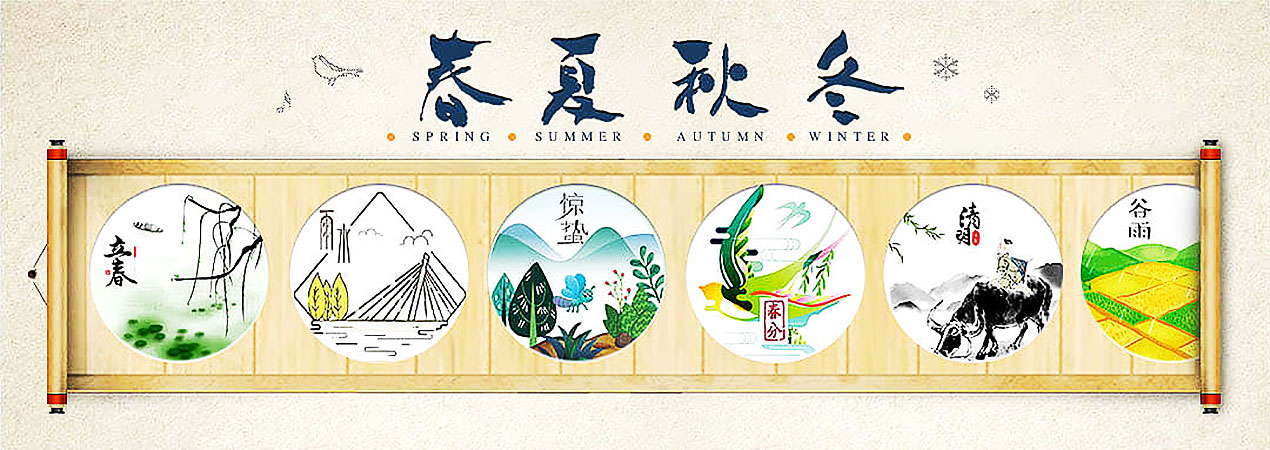
The 24 solar terms refer to the 24 particular occasions indicating seasonal changes in the Chinese lunar calendar, established according to the change of the Earth’s position on the ecliptic (the orbit on which the Earth rotates around the sun). The 24 solar terms reflect the sun’s annual apparent motion, so their dates are basically fixed in the Gregorian calendar.
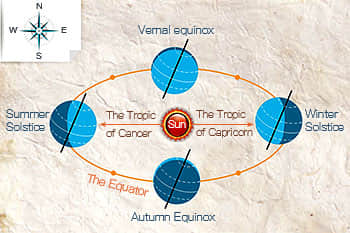
The concept of the 24 solar terms is an invention which is unique to Chinese calendar. Their key role in facilitating Chinese husbandry has continued for thousands of years right up until this date. Solar terms were first invented in the Yin and Shang dynasty, and the 24 solar terms did not come into being in full until the Western Han Dynasty.
The idea of the 24 solar terms was listed by UNESCO on Nov. 30, 2016 in the register of Masterpieces of the Oral and Intangible Heritage of Humanity. In the international meteorological community, the 24 solar terms are known as "China's fifth great invention."
- In Chinese: 二十四节气 (Èr Shí Sì Jié Qì)
- Dated back to: Pre-Qin period
- Implication: The Earth’s tropical movement and change of cold and hot seasons
- Origin: central region along the Yellow River basin (as historically China's major political, economic, cultural and agricultural activities centered on the central region along the Yellow River, the 24 solar terms were established based on the climatology and phenology in this area).
The 24 solar terms and twelve zodiac signs
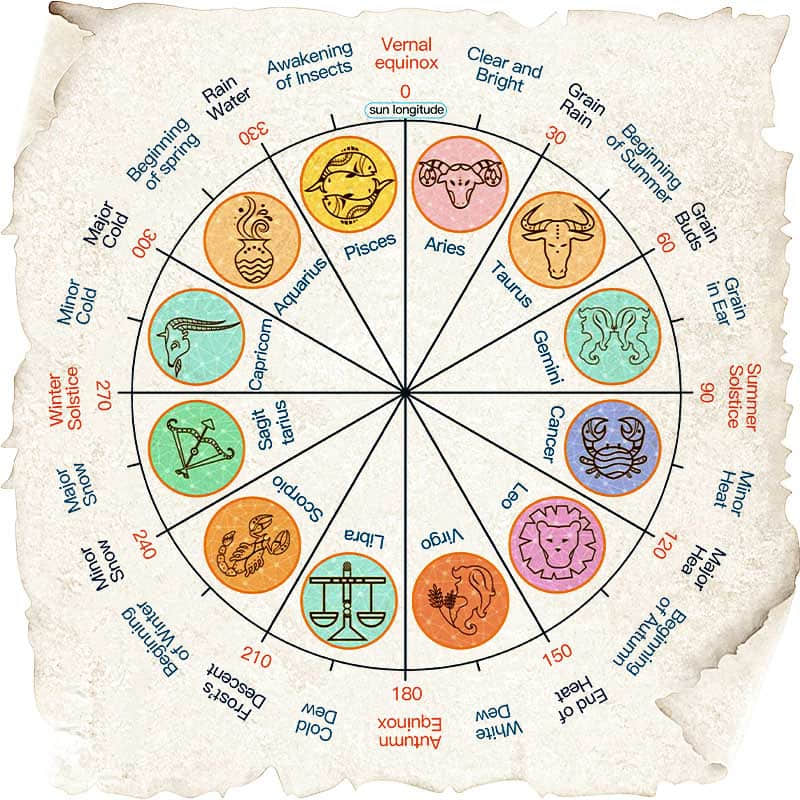
The 24 solar terms are defined according to the change of the Earth’s position on the ecliptic (the orbit on which the Earth rotates around the sun). As the sun sets off from the spring equinox (celestial longitude of zero degrees, when the sun vertically shines on the equator), every 15 degrees forward represents a term. After one cycle, it returns to the spring equinox, and that constitutes a tropical year with a rotation of 360 degrees. As for the twelve zodiac signs, the alternation of one sign takes place every 30 degrees, starting from Aries on the spring equinox, and returning to the spring equinox after a full rotation.
The 24 solar terms and four seasons
The four seasons are defined based on the 24 solar terms. Spring: the season when the temperature rises from low to high; summer: the season when the temperature rises to the highest; autumn: the season when the temperature drops from high to low; winter: the season when the temperature drops to the lowest.
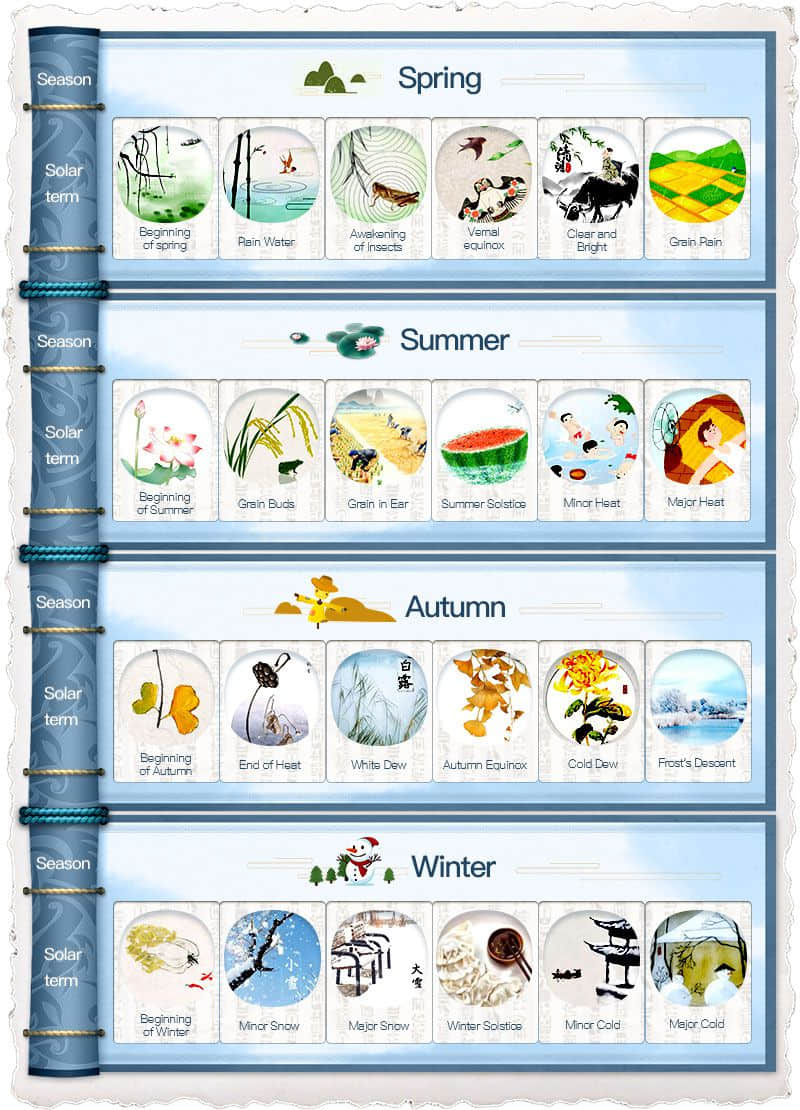
Spring: starting from Beginning of Spring, until Beginning of Summer, including the first, second and third months of the lunar calendar, and the second, third and fourth months of the solar calendar.
Summer: starting from Beginning of Summer, until Beginning of Autumn, including the fourth, fifth and sixth months of the lunar calendar, and the fifth, sixth and seventh months of the solar calendar.
Autumn: starting from Beginning of Autumn, until Beginning of Winter, including the seventh, eighth and ninth months of the lunar calendar, and the eighth, ninth and tenth months of the solar calendar.
Winter: starting from Beginning of Winter, until Beginning of Spring, including the tenth, eleventh and twelfth months of the lunar calendar, and the eleventh, twelfth and first months of the solar calendar.
Subject to the vast territory and distinct monsoon and continental climate in China, the four seasons start at different times in all parts of China, with different durations. For instance, hot summer begins from mid-April in some parts, while the spring warmth is just felt until early May in other parts. That is a huge difference from the seasons divided according to solar terms. Therefore, it would be more reasonable to divide the four seasons with the spill degree parameter, defining the seasons with average temperatures between 10℃ and 22℃ as spring and autumn, the season with an average temperature above 22℃ as summer, and the season with an average temperature below 10℃ as winter.
24 Solar Terms in 2025 / 2026 / 2027
| Solar Terms | Simplified / Traditional Chinese | Date |
|---|---|---|
| Lichun (Beginning of Spring) | 立春 / 立春 | February 4, 2026 / February 4, 2027 |
| Yushui (Rain Water) | 雨水 / 雨水 | February 18, 2026 / February 19, 2027 |
| Jingzhe (Awakening of Insects) | 惊蛰 / 驚蟄 | March 6, 2026 / March 6, 2027 |
| Chunfen (Spring Equinox) | 春分 / 春分 | March 20, 2026 / March 21, 2027 |
| Qingming (Clear and Bright) | 清明 / 清明 | April 5, 2026 / April 5, 2027 |
| Guyu (Grain Rain) | 谷雨 / 穀雨 | April 20, 2026 / April 20, 2027 |
| Lixia (Beginning of Summer) | 立夏 / 立夏 | May 5, 2026 / May 6, 2027 |
| Xiaoman (Grain Buds) | 小满 / 小滿 | May 21, 2026 / May 21, 2027 |
| Mangzhong (Grain in Ear) | 芒种 / 芒種 | June 5, 2026 / June 6, 2027 |
| Xiazhi (Summer Solstice) | 夏至 / 夏至 | June 21, 2026 / June 21, 2027 |
| Xiaoshu (Minor Heat) | 小暑 / 小暑 | July 7, 2026 / July 7, 2027 |
| Dashu (Major Heat) | 大暑 / 大暑 | July 23, 2026 / July 23, 2027 |
| Liqiu (Beginning of Autumn) | 立秋 / 立秋 | August 7, 2026 / August 8, 2027 |
| Chushu (End of Heat) | 处暑 / 處暑 | August 23, 2026 / August 23, 2027 |
| Bailu (White Dew) | 白露 / 白露 | September 7, 2026 / September 8, 2027 |
| Qiufen (Autumn Equinox) | 秋分 / 秋分 | September 23, 2026 / September 23, 2027 |
| Hanlu (Cold Dew) | 寒露 / 寒露 | October 8, 2026 / October 8, 2027 |
| Shuangjiang (Frost's Descent) | 霜降 / 霜降 | October 23, 2026 / October 23, 2027 |
| Lidong (Beginning of Winter) | 立冬 / 立冬 | November 7, 2025 / November 7, 2026 |
| Xiaoxue (Minor Snow) | 小雪 / 小雪 | November 22, 2025 / November 22, 2026 |
| Daxue (Major Snow) | 大雪 / 大雪 | December 7, 2025 / December 7, 2026 |
| Dongzhi (Winter Solstice) | 冬至 / 冬至 | December 21, 2025 / December 22, 2026 |
| Xiaohan (Minor Cold) | 小寒 / 小寒 | January 5, 2026 / January 5, 2027 |
| Dahan (Major Cold) | 大寒 / 大寒 | January 20, 2026 / January 20, 2027 |
OR
Are you eager to begin your Chinese cultural journey?
Drop us a line and we will promptly connect you with our leading China expert!
 Chinese Kung Fu
Chinese Kung Fu 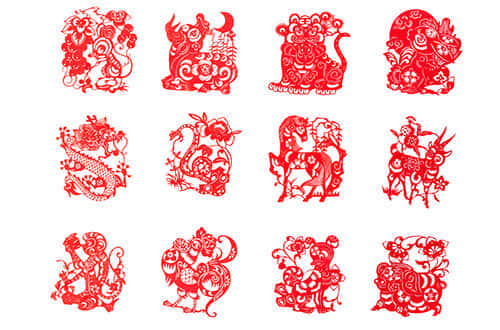 Chinese Zodiac
Chinese Zodiac 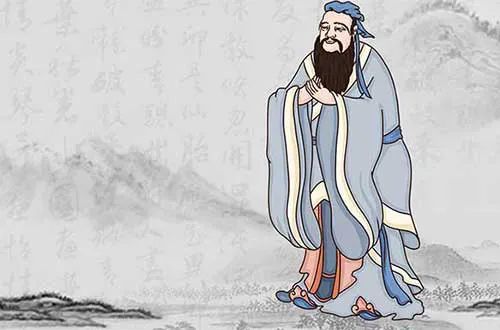 Confucianism
Confucianism  How Chinese Palmistry Works
How Chinese Palmistry Works